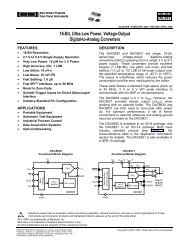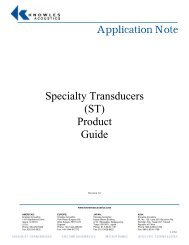AD7714* 3 V/5 V, CMOS, 500 µA Signal Conditioning ADC - dreamm
AD7714* 3 V/5 V, CMOS, 500 µA Signal Conditioning ADC - dreamm
AD7714* 3 V/5 V, CMOS, 500 µA Signal Conditioning ADC - dreamm
Create successful ePaper yourself
Turn your PDF publications into a flip-book with our unique Google optimized e-Paper software.
AD7714<br />
AD7714-3 OUTPUT NOISE<br />
Table IIa shows the output rms noise and effective resolution for some typical notch and –3 dB frequencies for the AD7714-3 with<br />
f CLK IN = 2.4576 MHz while Table IIb gives the information for f CLK IN = 1 MHz. The numbers given are for the bipolar input<br />
ranges with a V REF of +1.25 V and BUFFER = 0. These numbers are typical and are generated at an analog input voltage of 0 V.<br />
The numbers in brackets in each table are for the effective resolution of the part (rounded to the nearest 0.5 LSB). The effective<br />
resolution of the device is defined as the ratio of the output rms noise to the input full scale (i.e., 2 × V REF /GAIN). It should be<br />
noted that it is not calculated using peak-to-peak output noise numbers. Peak-to-peak noise numbers can be up to 6.6 times the rms<br />
numbers while effective resolution numbers based on peak-to-peak noise can be 2.5 bits below the effective resolution based on rms<br />
noise as quoted in the tables.<br />
The output noise from the part comes from two sources. The first is the electrical noise in the semiconductor devices used in the<br />
implementation of the modulator (device noise). Secondly, when the analog input signal is converted into the digital domain, quantization<br />
noise is added. The device noise is at a low level and is largely independent of frequency. The quantization noise starts at<br />
an even lower level but rises rapidly with increasing frequency to become the dominant noise source. Consequently, lower filter<br />
notch settings (below 100 Hz approximately for f CLK IN = 2.4576 MHz and below 40 Hz approximately for f CLK IN = 1 MHz) tend to<br />
be device noise dominated while higher notch settings are dominated by quantization noise. Changing the filter notch and cutoff frequency<br />
in the quantization noise dominated region results in a more dramatic improvement in noise performance than it does in the<br />
device-noise dominated region as shown in Table II. Furthermore, quantization noise is added after the PGA, so effective resolution<br />
is largely independent of gain for the higher filter notch frequencies. Meanwhile, device noise is added in the PGA and, therefore, effective<br />
resolution suffers a little at high gains for lower notch frequencies. Additionally, in the device-noise dominated region, the<br />
output noise (in µV) is largely independent of reference voltage while in the quantization-noise dominated region, the noise is proportional<br />
to the value of the reference. It is possible to do post-filtering on the device to improve the output data rate for a given<br />
–3 dB frequency and also to further reduce the output noise.<br />
At the lower filter notch settings (below 60 Hz for f CLK IN = 2.4576 MHz and below 25 Hz for f CLK IN = 1 MHz), the no missing<br />
codes performance of the device is at the 24-bit level. At the higher settings, more codes will be missed until at 1 kHz notch setting<br />
for f CLK IN = 2.4576 MHz (400 Hz for f CLK IN = 1 MHz), no missing codes performance is only guaranteed to the 12-bit level.<br />
Table IIa. AD7714-3 Output Noise/Resolution vs. Gain and First Notch for f CLK IN = 2.4576 MHz, BUFFER = 0<br />
Filter First<br />
Typical Output RMS Noise in µV (Effective Resolution in Bits)<br />
Notch & O/P –3 dB Gain of Gain of Gain of Gain of Gain of Gain of Gain of Gain of<br />
Data Rate Frequency 1 2 4 8 16 32 64 128<br />
5 Hz 1.31 Hz 1.07 (21) 0.68 (21) 0.29 (21) 0.24 (20) 0.22 (19.5) 0.22 (18.5) 0.22 (17.5) 0.22 (16.5)<br />
10 Hz 2.62 Hz 1.69 (20.5) 1.1 (20) 0.56 (20) 0.35 (19.5) 0.33 (19) 0.33 (18) 0.33 (17) 0.33 (16)<br />
25 Hz 6.55 Hz 3.03 (19.5) 1.7 (19.5) 0.89 (19.5) 0.55 (19) 0.49 (18.5) 0.46 (17.5) 0.46 (16.5) 0.45 (15.5)<br />
30 Hz 7.86 Hz 3.55 (19.5) 2.1 (19) 1.1 (19) 0.61 (18.5) 0.58 (18) 0.57 (17) 0.55 (16) 0.55 (15)<br />
50 Hz 13.1 Hz 4.72 (19) 2.3 (19) 1.5 (18.5) 0.84 (18.5) 0.7 (18) 0.68 (17) 0.67 (16) 0.66 (15)<br />
60 Hz 15.72 Hz 5.12 (19) 3.1 (18.5) 1.6 (18) 0.98 (18) 0.9 (17.5) 0.7 (17) 0.69 (16) 0.68 (15)<br />
100 Hz 26.2 Hz 9.68 (18) 5.6 (18) 2.4 (18) 1.3 (18) 1.1 (17) 0.95 (16.5) 0.88 (15.5) 0.9 (14.5)<br />
250 Hz 65.5 Hz 44 (16) 31 (15.5) 15 (15.5) 5.8 (15.5) 3.7 (15.5) 2.4 (15) 1.8 (14.5) 1.8 (13.5)<br />
<strong>500</strong> Hz 131 Hz 304 (13) 129 (13) 76 (13) 33 (13) 20 (13) 11 (13) 6.3 (12.5) 3 (12.5)<br />
1 kHz 262 Hz 1410 (11) 715 (11) 350 (11) 177 (11) 101 (10.5) 51 (10.5) 31 (10.5) 12 (10.5)<br />
Table IIb. AD7714-3 Output Noise/Resolution vs. Gain and First Notch for f CLK IN = 1 MHz, BUFFER = 0<br />
Filter First<br />
Typical Output RMS Noise in µV (Effective Resolution in Bits)<br />
Notch & O/P –3 dB Gain of Gain of Gain of Gain of Gain of Gain of Gain of Gain of<br />
Data Rate Frequency 1 2 4 8 16 32 64 128<br />
2 Hz 0.52 Hz 0.86 (21.5) 0.58 (21) 0.32 (21) 0.21 (20.5) 0.2 (19.5) 0.2 (18.5) 0.2 (17.5) 0.2 (16.5)<br />
4 Hz 1.05 Hz 1.26 (21) 0.74 (20.5) 0.44 (20.5) 0.35 (20) 0.3 (19) 0.3 (18) 0.3 (17) 0.3 (16)<br />
10 Hz 2.62 Hz 1.68 (20.5) 1.33 (20) 0.73 (20) 0.5 (19) 0.49 (18.5) 0.49 (17.5) 0.48 (16.5) 0.47 (15.5)<br />
25 Hz 6.55 Hz 3.82 (19.5) 2.0 (19.5) 1.2 (19) 0.88 (18.5) 0.66 (18) 0.57 (17) 0.55 (16) 0.55 (15)<br />
30 Hz 7.86 Hz 4.88 (19) 2.1 (19) 1.3 (19) 0.93 (18.5) 0.82 (17.5) 0.69 (17) 0.68 (16) 0.66 (15)<br />
50 Hz 13.1 Hz 11 (18) 4.8 (18) 2.4 (18) 1.4 (18) 1.4 (17) 0.73 (16.5) 0.71 (15.5) 0.7 (15)<br />
60 Hz 15.72 Hz 14.7 (17.5) 7.5 (17.5) 3.8 (17.5) 2.6 (17) 1.5 (16.5) 0.95 (16.5) 0.88 (15) 0.9 (14.5)<br />
100 Hz 26.2 Hz 61 (15.5) 30 (15.5) 12 (15.5) 6.1 (15.5) 2.9 (15.5) 2.4 (15) 1.8 (14.5) 1.8 (13.5)<br />
200 Hz 52.4 Hz 275 (13) 130 (13) 65 (13) 33 (13) 17 (13) 11 (13) 6.3 (12.5) 3 (12.5)<br />
400 Hz 104.8 Hz 1435 (11) 720 (11) 362 (11) 175 (11) 110 (10.5) 51 (10.5) 31 (10.5) 12 (10.5)<br />
–10–<br />
REV. B















